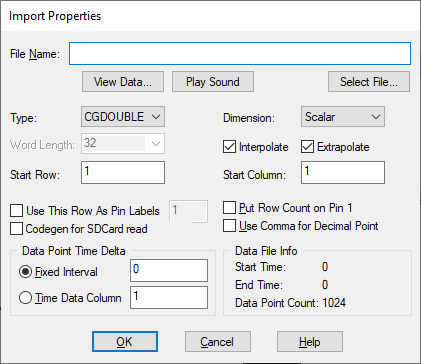

Block Category: Signal Producer
Description: The import block imports data generated by other applications. The types of data that can be imported using the import block are:
•Data files (DAT)
•Comma separated text files (CSV)
•Binary matrix, ASCII matrix, and general text data files (M, MAT, and TXT)
•8-bit or 16-bit sound files (WAV)
•Excel spreadsheets (XLSX)
The import block reads data points from the specified input file into the system model and translates the data points into scalar, vector, or matrix output signals. The data can be either fixed interval or asynchronous.
The import block is particularly useful for comparing experimental data with simulated results and for inserting trial control data from an external source.
Setting up the input file: The input file can contain a header line to describe the separation of data points. The following table describes the header line format:
|
Interval type |
Format |
|
Fixed |
#I=start-time, end-time, increment |
|
Asynchronous |
#T=number (time-column) |

Codegen for SDCard read: When activated, generates code for the file I/O on the SD card plugged into a Concerto. This parameter is used only with Embed.
Data Point Count: Indicates the maximum number of data points to be read into Embed. If the input file was generated in Embed using the export block, Embed automatically reads the data point count from the file header and sets the field accordingly. The maximum number of data points that can be read into Embed is 250 million.
Start Time and End Time: Indicate when Embed starts and stops recording data.
Data Point Time Delta: Indicates the time interval between data points in the input file. If the input file was generated by Embed using the export block, Embed automatically reads the time interval information from the file header and sets the parameter accordingly.
Dimension: Controls the dimensionality of the output signals. The choices are scalar, vector, and matrix.
Extrapolate: Infers the next unknown data point based on the difference between the last two known data points.
File Name: Indicates the file to be used as input to Embed. You can specify CSV, DAT, M, MAT, TXT, WAV, or XLSX files. If you do not know the name or location of the input file, click Select File to locate and choose a file.
You can use macros in all or part of the file specification.
To browse or edit the input file, click Browse Data after you select a file to open the file in the default text editor.
Fixed Interval: Indicates that data points occur in fixed intervals. Enter the interval in the corresponding box. This is the default setting.
Interpolate: Interpolates between two data points, instead of using the last known data value. Thus, if the data point is 5 at t1, and 15 at t2, then at t1.5, the data point is 10 with, 5 with no interpolation.
Play Sound: When you specify a WAV file, you can play the sounds you imported by clicking Play Sound.
Put Row Count On Pin 1: When activated, pin (connector label) 1 displays the total number of rows in the data file.
Start Column: In a multi-column file, you can choose the column that corresponds to the top-most connector tab. The default value 1 corresponds to the first column.
Time Data Column: Indicates that data points occur in irregular time intervals. Enter the column containing the time data points in the corresponding box. Valid column numbers are 1 through 16.
Type: Indicates the type of data to be imported.
Use Comma For Decimal Point: Uses a comma as the decimal point character to support users outside North America.
Use This Row As Pin Labels: Lets you enter a row to be used as pin labels. If you do not enter a row, no pin labels are used.
See the export block example.